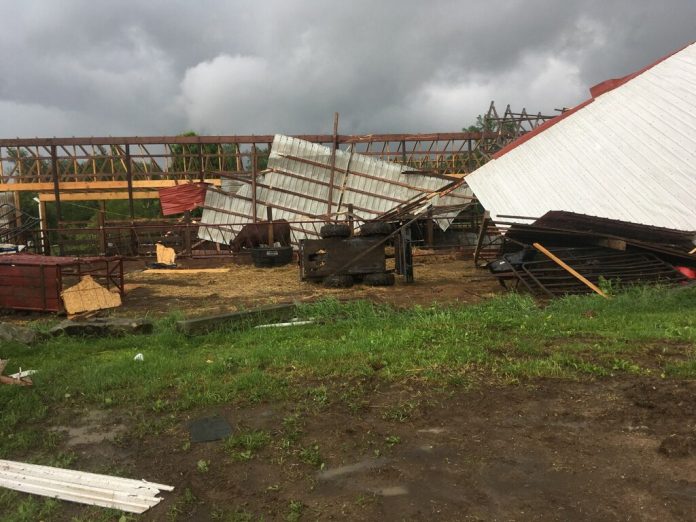
As the number of straight-line wind and tornado events in Ohio seems to be increasing so does the number of times that parts of nearby buildings end up spread out across our pastures and hay fields. This debris can cause significant health risks to grazing livestock, as well as animals that are fed harvested forages from these fields.
Debris that is blown into pastures and hayfields quickly becomes hard to see as forages take off and grows in the spring. In pastures or stored hay, livestock often eat foreign materials that are present in the field either mixed in with the forage or just from curiosity. There is also a risk of livestock being injured from foreign materials entering the animal’s hooves or being tangled in the debris in a pasture. Each type of debris can cause slightly different challenges.
Large debris such as roofing, boards and other debris scattered by the storm are the easiest to see and clean up. Once the large debris is no longer visible, it is easy to move on to the next cleanup project, but the small stuff needs cleaned-up just as badly.
Fiberglass
Fiberglass insulation can be especially challenging as it can lead to blockages, bloat and irritation of the digestive tract. Small amounts of fiberglass may create small cuts in the esophagus causing irritation when the animal eats even after the bite that contained fiberglass. It can also cause small cuts that bleed in the digestive tract causing bloody manure.
Besides eating fiberglass insulation spread around the pasture, there is also a risk of the small fibers being breathed in while the animal is eating. If making hay from a field contaminated with fiberglass, the hay should not be sold. If a lot of fiberglass is present, an early cutting that is not fed could be an option. If small amounts of fiberglass are in the hay, it should be fed only for a short amount of time.
This could be feeding it to finishing cattle or feeding it to breeding stalk only for a short amount of time before rotating to a different forage source. If your animals have been exposed to fiberglass and are sick be sure to let your veterinarian know of the exposure so that they include this risk as a possibility when determining why your animals are ill.
Metal
Small amounts of metal debris and nails are an even bigger concern for ruminates. When ruminates eat metal it can perforate the reticulum, allowing ingesta and bacteria to leak into the peritoneal cavity, resulting in peritonitis and often leading to adhesions in the abdomen.
To prevent this problem a magnet pill may be given that goes into the animal’s rumen. This prevents metal objects from harming the animal’s digestive tract. If the field is harvested as hay or silage, additional magnets can be added to help trap the metal.
The first forage harvester with a metal detector was released in 1977 with most new forage harvesters having this option on them. The metal detector not only protects the chopper knives but also your livestock. Modern metal detectors can find small pieces of metal that your eyes won’t even see. Plan extra time to chop forage from fields that contain debris and have a plan of where you can put forage that has metal in that you can’t find.
If baling the hay, look for places you can add magnets to your baler pickup. Unlike a metal stop, these magnets will need cleaned off often. As metal builds up on the magnet it becomes more likely that the hay will pull the metal off the magnet. Another way to catch metal in baled forage is to process the bale instead of feeding it whole, allowing you to have additional chances for the forage to flow across a magnet. On TMR mixers, magnets can be installed on the forage discharge to catch small pieces of metal that are present; but to catch the metal, feed must be unloaded slowly so that it is not too deep when going over the magnet. Magnets can also be added to bale grinders on the discharge to help catch metal that may be present in the hay.
One newer tool to assist with making sure fields are debris-free is to have the field flow with drone imagery.
Take time to check. Unfortunately, livestock producers deal with storm debris scattered through their fields somewhere in the country all the time. If you have been adversely affected by storm damage, good luck with your cleanup.












